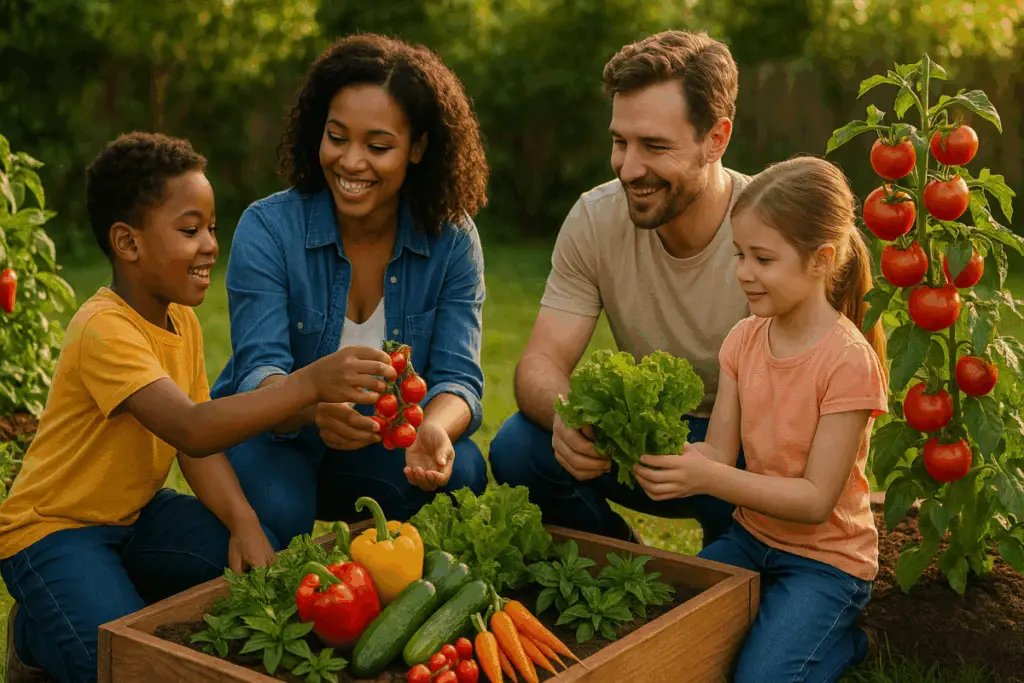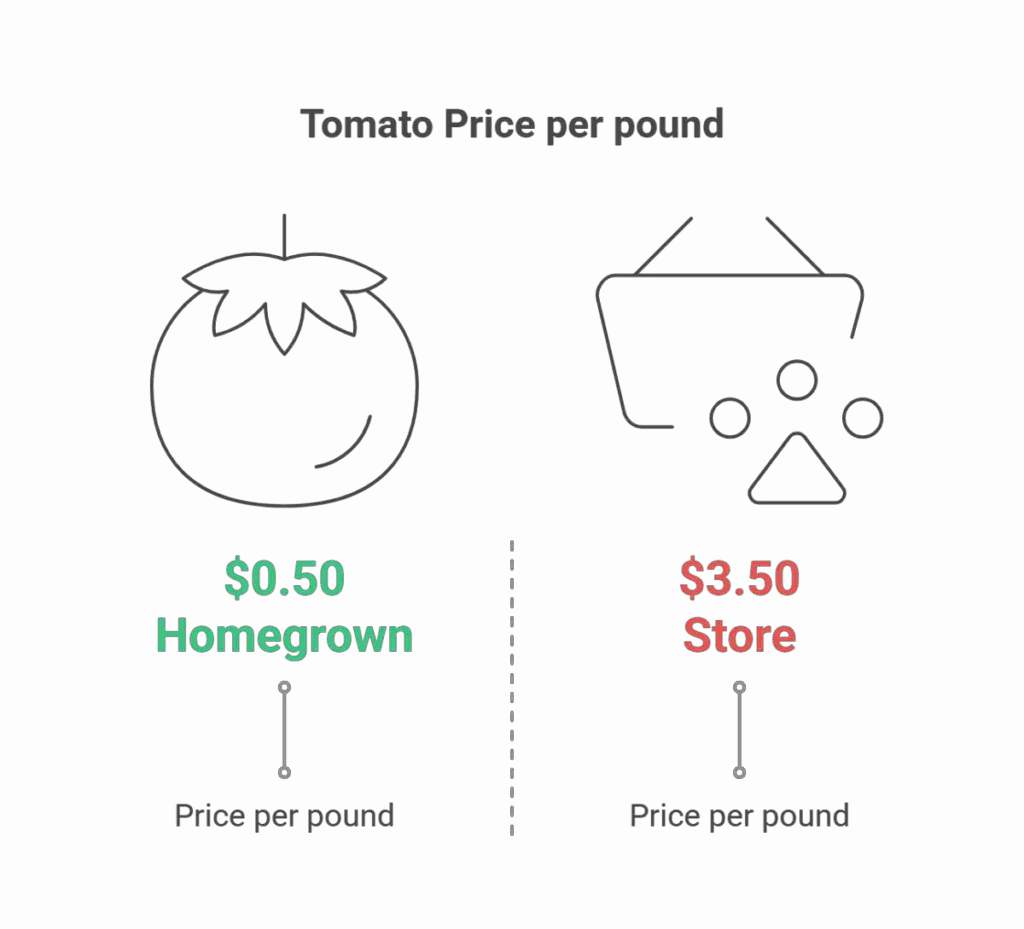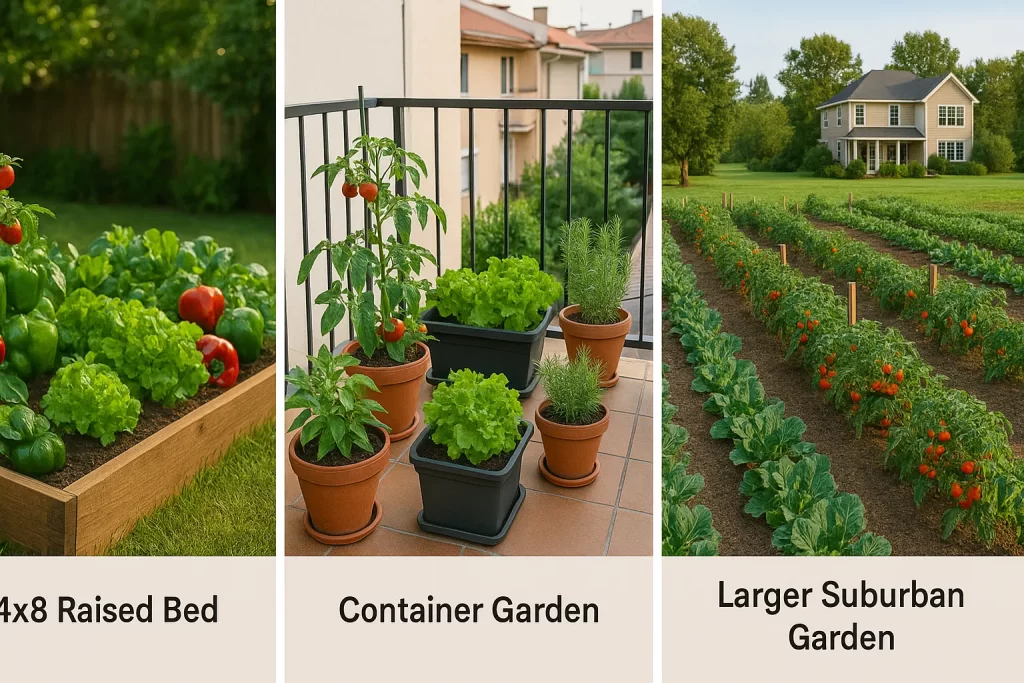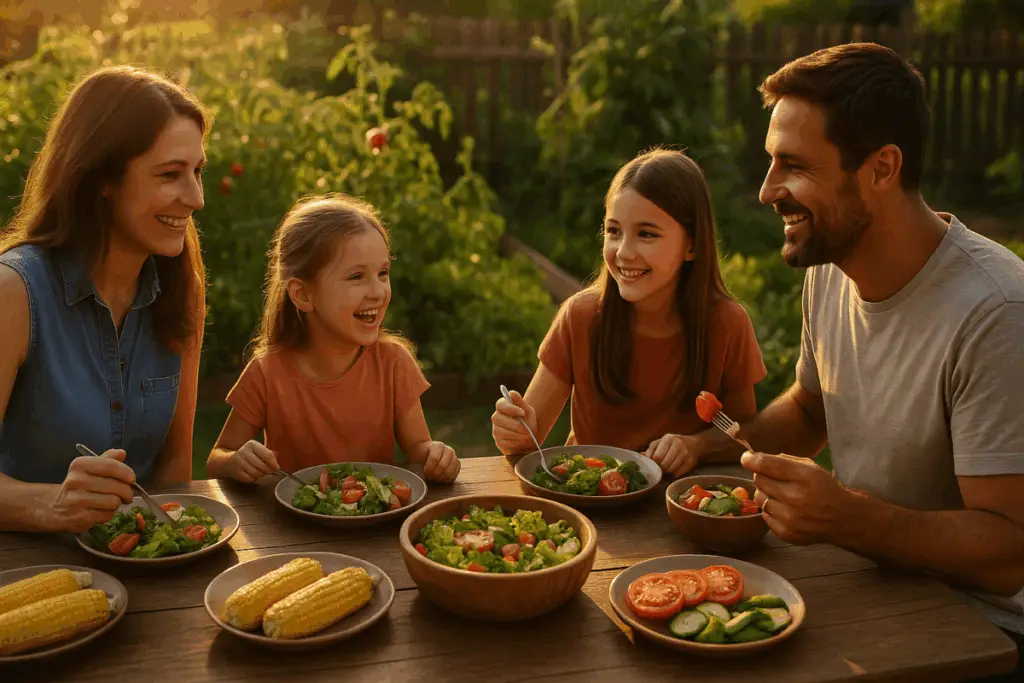
Picture this: You walk out to your backyard and fill up a basket with fresh tomatoes, crisp lettuce, and vibrant peppers. Instead of heading to the grocery store, you just saved yourself $40 for the week. Sound too good to be true? It’s not.
With grocery costs hitting families harder than ever—Americans now spend more than $7,600 per person annually on food—it’s time to take control of your food budget. Here’s the real deal: you can build a productive food garden for just $200 that will save you $2000 or more on groceries each year.
I’m going to walk you through exactly how to do it, from your first shovel full of dirt to your first harvest dinner. No fluff, no complicated techniques—just practical advice that works.

Breaking Down the Math: Is $2000 in Savings Really Possible?
Let’s be honest here—when I first heard about saving $2000 from a $200 garden, I was skeptical too. But after looking at the numbers and talking to families who’ve actually done it, the math checks out pretty well.
Here’s how a typical family of four breaks down their grocery savings:
- Tomatoes: $300-400 saved annually (store price: $3-4/lb vs. homegrown: $0.50/lb)
- Lettuce and greens: $250-350 saved (store price: $2-3/head vs. homegrown: $0.25/head)
- Fresh herbs: $200-300 saved (store price: $2-3/package vs. homegrown: $0.10/serving)
- Bell peppers: $150-200 saved (store price: $1.50-2/pepper vs. homegrown: $0.25/pepper)
- Cucumbers: $100-150 saved (store price: $1-2/cucumber vs. homegrown: $0.20/cucumber)
That’s already $1000-1400 right there, and we’re just getting started.
The key is growing high-value crops that your family actually eats. There’s no point growing tons of zucchini if nobody in your house likes zucchini bread. Focus on the vegetables that show up in your grocery cart week after week.
One family I know in Ohio tracked their savings for a full year. They spent $185 on their initial garden setup and saved $1,847 on groceries. Not bad for a few hours of work each week.

Your $200 Investment Breakdown: Every Dollar Accounted For
Alright, let’s talk money. Here’s exactly where your $200 goes:
Seeds and Plants: $35-45
- High-value vegetable seeds: $20-25 (tomatoes, peppers, herbs, greens)
- Quick-growing crops: $10-15 (radishes, lettuce, spinach)
- Starter plants for tricky crops: $5-10 (if you want to skip the seed-starting phase)
Basic Tools: $50-70
- Hand shovel: $15-20
- Garden rake: $15-20
- Hose or watering can: $10-15
- Hand weeder: $8-12
- Pruning shears: $10-15
Soil and Amendments: $60-80
- Compost or aged manure: $25-35 (2-3 bags)
- Basic fertilizer: $15-20
- Seed starting mix: $10-15 (if starting from seed)
- Mulch: $10-15 (to keep weeds down)
Garden Infrastructure: $50-75
- Raised bed materials or containers: $30-50 (cedar boards or large containers)
- Hardware cloth for pest protection: $10-15
- Support stakes or cages: $10-15
Total: $195-270
Now, you might be thinking, “That’s more than $200!” And you’re right. But here’s the thing—you don’t need everything at once. Start with the basics and add as you go. You can easily get started with $150-180 and build from there.
Space Requirements: Gardens for Every Living Situation
Good news: You don’t need a huge backyard to make this work.
The Sweet Spot: 4×8 Feet
A 4×8 foot raised bed is about the size of a small parking space, and it’s perfect for a family of four. You can grow:
- 4 tomato plants
- 2 pepper plants
- A row of lettuce (succession planted)
- A row of herbs
- Quick crops like radishes and spinach
Apartment Dwellers: Container Solutions
Living in an apartment? No problem. You can grow $800-1200 worth of vegetables using:
- 5-gallon buckets for tomatoes and peppers (6-8 buckets)
- Window boxes for herbs and greens
- Vertical planters for strawberries and trailing crops
Suburban Optimization
Got a bigger yard? Great! You can scale up easily. For every additional 4×4 foot section, add about $300-400 in annual savings.
The University of Minnesota Extension recommends choosing a spot with full sun and good drainage. Keep it simple—pick the sunniest spot in your yard and go from there.

The High-ROI Vegetable Selection Strategy
Here’s where we get smart about plant selection. Not all vegetables are created equal when it comes to saving money.
Tier 1: The Money Makers ($200+ annual savings each)
Tomatoes: Your absolute best investment. One healthy plant produces 10-15 pounds of tomatoes. At $3-4/pound in stores, that’s $30-60 per plant.
Lettuce and Salad Greens: These babies grow fast and you can harvest them multiple times. One packet of seeds ($2) gives you $50+ worth of salad.
Fresh Herbs: Basil, cilantro, parsley—they’re expensive in stores but dirt cheap to grow. One basil plant gives you a summer’s worth of pesto.
Tier 2: Solid Performers ($100-200 annual savings each)
Bell Peppers: Slow to start but each plant produces 8-12 peppers. At $1.50-2 each in stores, the math works out nicely.
Cucumbers: These guys are prolific. One plant can give you 20-30 cucumbers over the season.
Green Beans: Plant once, harvest for weeks. Kids love picking them too.
Tier 3: Space Fillers ($50-100 annual savings each)
Radishes: Ready in 30 days. Perfect for filling gaps and getting quick wins.
Spinach: Grows in cool weather when other crops are slowing down.
Carrots: Takes longer but stores well and kids love pulling them up.
Here’s a pro tip: Focus 70% of your space on Tier 1 crops. They’re your money makers. Use the remaining 30% for Tier 2 and 3 crops that your family loves.
Timeline and Seasonal Planning: Your Year-Round Savings Schedule
Let me walk you through what a successful garden year looks like. This isn’t about perfection—it’s about getting good results with reasonable effort.
Spring (March-May): Getting Started
Early Spring: Start your tomato and pepper seeds indoors. If that sounds intimidating, just buy starter plants later.
Mid-Spring: Plant cool-season crops like lettuce, spinach, and radishes. These guys can handle a little frost.
Late Spring: Once the danger of frost is past, plant your warm-season crops like tomatoes, peppers, and cucumbers.
Summer (June-August): Prime Time
This is when your garden really starts paying off. You’ll be harvesting something almost every day.
Early Summer: First tomatoes, continuous lettuce harvests, herbs galore.
Mid-Summer: Peak production time. This is when you’ll see the biggest grocery savings.
Late Summer: Time to plant fall crops like more lettuce and spinach.
Fall (September-November): Extended Harvest
Don’t pack it in when summer ends. Fall gardening can extend your savings by 2-3 months.
Early Fall: Harvest continues, plus new plantings of cool-season crops.
Late Fall: Final harvests, garden cleanup, planning for next year.
Winter (December-February): Planning and Prep
Use this time to plan next year’s garden and maybe try some indoor herb growing.
The University of Maryland Extension has great resources for timing your plantings based on your location.
Family Size Scaling Guide
Let’s talk about matching your garden to your family’s needs. A single person doesn’t need the same setup as a family of six.
Single Person or Couple: Micro Garden ($150 investment, $600-800 savings)
- 3×6 foot raised bed or 6-8 containers
- Focus on: Herbs, lettuce, tomatoes (2 plants), peppers (1 plant)
- Time commitment: 3-4 hours per week
Family of 3-4: Standard Garden ($200 investment, $1200-1600 savings)
- 4×8 foot raised bed or equivalent containers
- Focus on: Everything mentioned above, plus cucumbers, beans
- Time commitment: 5-6 hours per week
Family of 5-6: Expanded Garden ($300 investment, $1800-2400 savings)
- 6×8 foot raised bed or multiple 4×4 sections
- Add: More tomato plants, winter squash, additional successions
- Time commitment: 7-8 hours per week
Large Family (7+): Full Production ($400 investment, $2500+ savings)
- Multiple raised beds or 200+ square feet
- Consider: Preservation crops, bulk storage vegetables
- Time commitment: 10-12 hours per week
Here’s the key: Start smaller than you think you need. It’s better to have a successful small garden than an overwhelming large one. You can always expand next year.
Complete Beginner’s Implementation Guide
Never grown anything before? No worries. Here’s your step-by-step action plan.
Week 1: Site Prep and Planning
- Choose your location: 6+ hours of sunlight, accessible to water
- Decide on raised bed vs. containers: Raised beds are easier long-term
- Order your supplies: Get everything delivered at once to save on shipping
Week 2: Build Your Growing Space
- Assemble raised bed: 2-3 hours with basic tools
- Fill with soil: Mix compost with existing soil or bagged soil
- Plan your layout: Sketch where each plant will go
Week 3: Plant Your Garden
- Start with easy crops: Lettuce, radishes, herbs
- Plant tomatoes and peppers: After last frost date for your area
- Water thoroughly: But don’t overdo it
Week 4: Establish Your Routine
- Daily check: 5-10 minutes each morning
- Weekly deep care: 1-2 hours on weekends
- Track your progress: Take photos, note what’s working
Beginner’s biggest mistake: Trying to do too much at once. Start simple, get some wins under your belt, then expand.
The Rutgers University Extension has excellent guidance on garden site selection and soil preparation.
Maximizing Your Investment: Time and Maintenance
Let’s be real about the time commitment. A productive food garden isn’t a set-it-and-forget-it operation, but it’s not a full-time job either.
Daily Tasks (10-15 minutes)
- Quick visual check: Any problems developing?
- Harvest ready vegetables: Pick them when they’re ready
- Spot watering: During hot weather
Weekly Tasks (1-2 hours)
- Deep watering: Slow, thorough watering session
- Weeding: Easier to stay on top of it than catch up
- Pest check: Look for problems before they get big
Monthly Tasks (2-3 hours)
- Fertilizer application: Keep those plants fed
- Succession planting: Plant new crops as others finish
- General maintenance: Pruning, staking, etc.
Seasonal Tasks (4-6 hours per season)
- Spring: Garden setup, major planting
- Summer: Preservation activities, major harvest
- Fall: Garden cleanup, cover crop planting
- Winter: Planning, tool maintenance
Time-saving tips:
- Mulch heavily: Cuts weeding time by 70%
- Use drip irrigation: Set it and forget it watering
- Choose disease-resistant varieties: Less problem-solving needed
About the “free labor” question: Yes, you’re putting in time. But compare it to the time you spend grocery shopping, meal planning, and driving to the store. Many people find gardening relaxing—it’s their form of stress relief.
Dealing with Challenges: Pests, Diseases, and Crop Failures
Let’s talk about the things that can go wrong—and how to handle them without losing your mind or your investment.
Common Pest Issues and Simple Solutions
Aphids on your peppers? Spray them off with water or release some ladybugs. Don’t panic and reach for harsh chemicals right away.
Tomato hornworms? Pick them off by hand. They’re big and easy to spot. Your kids might actually enjoy the hunt.
Cucumber beetles? Row covers during early growth, then hand-picking. It’s gross but effective.
Disease Prevention (Easier Than Treatment)
- Good air circulation: Don’t crowd your plants
- Water at soil level: Wet leaves invite disease
- Clean tools: Wipe down pruners between plants
- Crop rotation: Don’t plant the same thing in the same spot every year
When Things Go Bad
Here’s the truth: You will lose some plants. I’ve been gardening for years and I still lose plants. The key is not letting one failure kill your whole garden.
Build in redundancy: Plant a few extra tomato plants, succession plant your lettuce, and don’t put all your eggs in one basket.
Learn from failures: Dead plants teach you more than perfect ones sometimes.
Keep perspective: Even if you lose 25% of your plants, you’re still way ahead financially.
Preserving and Storing Your Harvest
Here’s where your garden investment really pays off. Learning to preserve your harvest extends your savings into the off-season.
Simple Preservation Methods
Freezing (Easiest Method)
- Blanch vegetables for 2-3 minutes, then freeze
- Works great for: Green beans, corn, peppers, tomatoes
- Equipment needed: Just your regular kitchen setup
Dehydrating
- Herbs dry beautifully in a paper bag
- Tomatoes become amazing sun-dried tomatoes
- Peppers turn into flake seasonings
Basic Canning
- Start with high-acid foods like tomatoes
- Invest in a pressure canner for vegetables
- One weekend of canning can preserve months of harvest
Root Cellaring
- Store potatoes, carrots, and winter squash in cool, dark places
- A basement or garage works fine for basic storage
- If you don’t have ideal conditions, here are some creative alternatives to traditional root cellars that work great
- Properly stored vegetables last 3-6 months
Extending Your Savings
A family that preserves their harvest typically sees their garden savings jump from $1200 to $2000+ annually. You’re not just saving money during growing season—you’re cutting grocery bills all year long.
Pro tip: Start small with preservation. Master one method before moving to the next. Frozen vegetables are just as nutritious as fresh ones, and freezing is foolproof.

Ongoing Costs and Long-Term Planning
Let’s talk about what happens after your first year. The good news is that your costs drop significantly.
Year 2 and Beyond: $50-75 Annually
- Seeds: $15-25 (you’ll save some from year 1)
- Fertilizer: $15-20
- Replacement plants: $10-15
- Miscellaneous supplies: $10-15
Seed Saving (Advanced Savings)
Once you get comfortable, you can save seeds from:
- Tomatoes: Easiest to save, huge variety available
- Peppers: Save from your best producers
- Herbs: Let some go to seed naturally
- Beans: Just let some pods dry on the plant
Saved seeds can cut your annual costs to $25-35. Plus, you’ll develop varieties that are perfectly adapted to your specific garden conditions.
Long-Term Infrastructure
- Raised beds: Should last 10-15 years with basic maintenance
- Tools: Quality tools last decades with care
- Knowledge: Your most valuable asset, grows every year
Return on Investment Over Time
- Year 1: Break even or small profit
- Year 2: $1500-2000 in savings
- Year 3+: $2000+ in savings with minimal investment
After three years, you’re looking at a 10:1 return on your original investment. Show me a stock that does that reliably.
Real Success Stories and Case Studies
Let me share some real examples from families who’ve made this work.
The Johnson Family – Suburban Ohio
Setup: 6×8 raised bed, $220 initial investment Year 1 Results: $1,340 in tracked grocery savings Key crops: Tomatoes (8 plants), lettuce (succession planted), herbs, peppers Biggest surprise: “We ate salad every day for six months and never bought lettuce”
Sarah – Urban Apartment Dweller
Setup: Balcony container garden, $165 initial investment Year 1 Results: $840 in grocery savings Key crops: Herbs, cherry tomatoes, lettuce, peppers Biggest win: “My herb garden alone saved me $200. Fresh basil costs $3 at the store!”
The Martinez Family – Family of Six
Setup: Multiple 4×4 raised beds, $380 initial investment Year 1 Results: $2,180 in grocery savings Key strategy: Heavy focus on preservation and storage Lesson learned: “Start smaller next time. We were overwhelmed in August.”
Common Success Factors
- Started with easy crops: Built confidence before tackling challenging vegetables
- Focused on family favorites: Grew what they actually ate
- Tracked their savings: Kept receipts and calculated real numbers
- Learned from mistakes: Adjusted their approach in year 2
Getting Started: Your 30-Day Action Plan
Ready to get started? Here’s exactly what to do over the next 30 days.
Week 1: Planning and Shopping
Days 1-2: Choose your garden location and measure the space Days 3-4: Order your raised bed materials and tools online Days 5-7: Research your local last frost date and plan your planting calendar
Week 2: Site Preparation
Days 8-10: Assemble your raised bed (easier than you think) Days 11-13: Fill with soil and compost, let it settle Days 14: Order your seeds and starter plants
Week 3: Planting
Days 15-17: Plant cool-season crops (lettuce, spinach, radishes) Days 18-20: Set up your watering system Days 21: Take “before” photos of your garden
Week 4: Establishment Care
Days 22-24: Daily monitoring, adjust watering as needed Days 25-27: Plant warm-season crops if frost danger has passed Days 28-30: Establish your daily and weekly care routine
When Will You See Savings?
- 30 days: First radish and lettuce harvests
- 60 days: Serious salad production, herb harvests
- 90 days: First tomatoes, major grocery impact
- 120 days: Peak harvest season, maximum savings
Most important thing: Start imperfectly rather than waiting for perfect conditions. Your garden doesn’t need to be Instagram-worthy to save you money.
Frequently Asked Questions
What if I kill everything in my first year?
You probably won’t kill everything, but even if you do, you’re still learning valuable lessons. Most “garden failures” are actually partial successes—maybe your tomatoes struggled but your lettuce thrived. Focus on what worked and build from there.
Is this realistic for someone who travels frequently?
It depends on your travel schedule. If you’re gone for weeks at a time during growing season, stick to low-maintenance crops like herbs and consider automated watering systems. Weekend trips aren’t a problem with proper mulching and watering.
What about water costs?
A typical 4×8 garden uses about 1-2 gallons of water per day during peak season. At average water rates, that’s $20-40 in additional water costs annually. Still a tiny fraction of your grocery savings.
Can I do this if I rent my home?
Absolutely. Focus on container gardening or get permission for a small raised bed. Many landlords are fine with improvements that don’t permanently alter the property.
What’s the learning curve like?
Expect to feel overwhelmed for the first month, then things click into place. By month three, you’ll feel confident. By year two, you’ll be giving advice to other beginners.
Do I need to use organic methods?
Use whatever methods you’re comfortable with. Organic practices are generally safer and often more cost-effective, but the main goal is growing food that saves you money.
What if my soil is terrible?
Raised beds with purchased soil solve most soil problems. You can grow fantastic vegetables in containers with quality potting mix. If you’re concerned about contamination—especially in urban areas where lead and heavy metals might be present—check out our guide on testing for soil contamination and building safer raised beds. Don’t let poor native soil stop you.
How do I know if I’m actually saving money?
Track your grocery receipts for a month before you start gardening, then compare. Most families are surprised by how much they spend on the vegetables they could easily grow.
Your Garden Starts Today
Look, I’m not going to sugarcoat this—starting a food garden takes some work. You’ll get dirt under your fingernails, you’ll make mistakes, and yes, some plants will die.
But here’s what I know for sure: Every family I’ve worked with who stuck with it for one full season has saved significant money on groceries. Most save over $1000 in their first year. Many save much more.
The $200 investment is real. The $2000 in savings is real. The fresh tomatoes in December from your frozen harvest are real. The pride in feeding your family food you grew yourself? That’s real too.
Your garden doesn’t have to be perfect to work. It just has to be started.
So here’s my challenge: Pick one thing from this guide and do it this week. Order some seeds. Measure your garden space. Buy a bag of soil. Just start somewhere.
Because the best time to plant a garden was 20 years ago. The second best time is right now.


